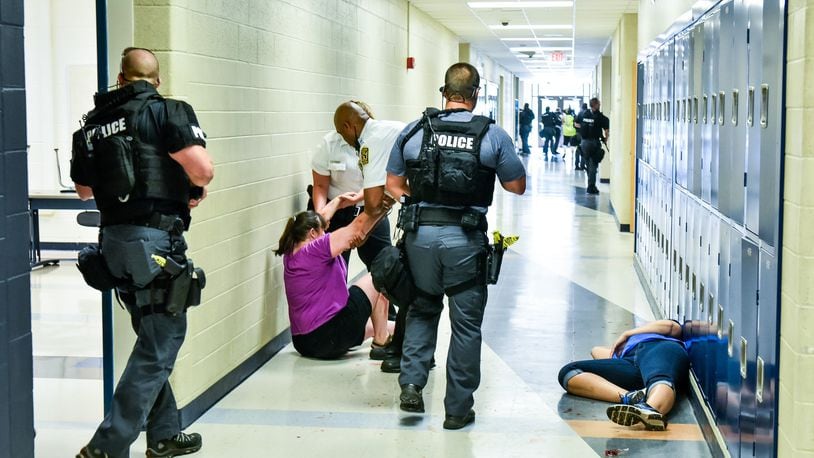RELATED: Laws will change Ohio school safety, suspensions
How did we get there?
Decades earlier
It’s not that mass shootings at schools didn’t happen before the 1990s, as the University of Texas tower shooting in 1966 and Stockton, Calif. schoolyard shooting in 1989 show. But they were less frequent. The bigger focus was often on issues of fights, drugs and later guns.
RELATED: A look at what local schools are doing to improve security
Late 90s massacres
Four multi-fatal school shootings in an eight-month span of 1997-98 shocked the country. Pearl, Miss., and West Paducah, Ky. first exploded onto TV screens, then Kip Kinkel in Oregon and two middle schoolers in Arkansas opened fire. Those incidents left 15 dead and 47 injured.
RELATED: Panel disagrees on armed officers in schools
After 11 months of relative quiet the Columbine, Colo., school massacre hit on April 20, 1999, leaving 15 dead. Schools around the nation took action.
Credit: Jefferson County Sheriff's Department via Getty Images
Credit: Jefferson County Sheriff's Department via Getty Images
Variety of steps
Active shooter procedures became No. 1 because mass shootings that had been nearly unthinkable had now happened five times in 18 months.
Ohio’s School Facilities Construction Commission added safety features to their design manual, meaning schools could get funding for security improvements. Tom Ash of the Buckeye Association of School Administrators said schools began, after Columbine, by building more fortified entrances.
EXPERTS: School safety focus needs to look beyond just shooters
“Before that, the whole point was, you didn’t even lock doors … for the simple reason that you wanted to engage the community. You wanted people coming in. And that all changed,” Ash said.
Education Week reported that growth in zero tolerance policies led to more suspensions and expulsions. Lockdown drills and other safety drills became common.
Sandy Hook and response
In December 2012, Adam Lanza shot and killed 20 first-graders and six school staff at Sandy Hook Elementary in Newtown, Conn.
By this point, school security was a growing industry, and Sandy Hook led to a massive response. More schools secured their buildings and considered features like shatterproof glass and emergency door-bars.
RELATED: Schools rely on behavior management plans
Some schools increased police presence or allowed staff to be armed, saying previous shooters had killed many before law enforcement could arrive. Students were trained not to let people in locked doors, even people they knew. Schools added high-tech camera systems to help them monitor campuses.
Outside of school policy, some pushed for stronger national gun control, including better background checks and curbs on certain powerful guns, high-capacity magazines and tools to alter legal guns. Others have advocated in the opposite direction, seeking policies that added armed staff to building or which gave school personnel access to weapons and training.
Mental health
School shootings by boys and men with known mental health issues, including Lanza and Nikolas Cruz — who killed 17 in Parkland, Fla. last year – have also led to calls for better mental health services in schools.
There’s now push-back, in Ohio and nationally, against widespread suspension and expulsion of misbehaving students. Efforts are now focusing on providing counseling and therapy in hopes of helping students deal with their emotions without resorting to violence.
VIDEO: Parkland school shooter’s statement released
“What we have always done has been response to a potential threat,” Ash said. “I think we’re moving toward prevention and identification instead. And that’s going to involve mental health professionals and social workers.”
Ash called school safety “a constantly changing landscape” – one that is sure to keep evolving in coming years.
About the Author
